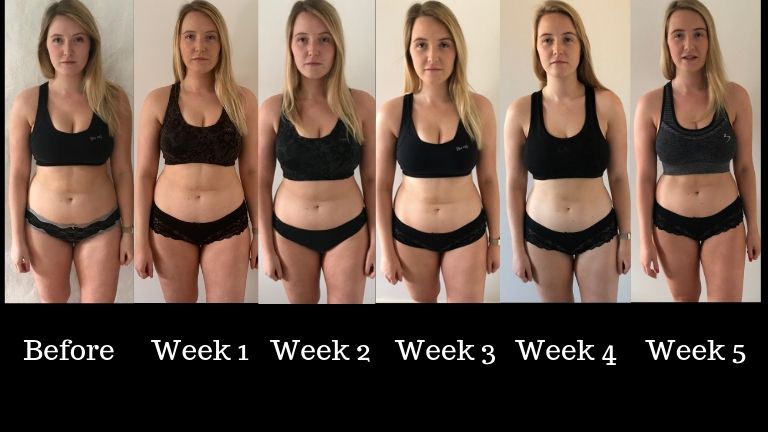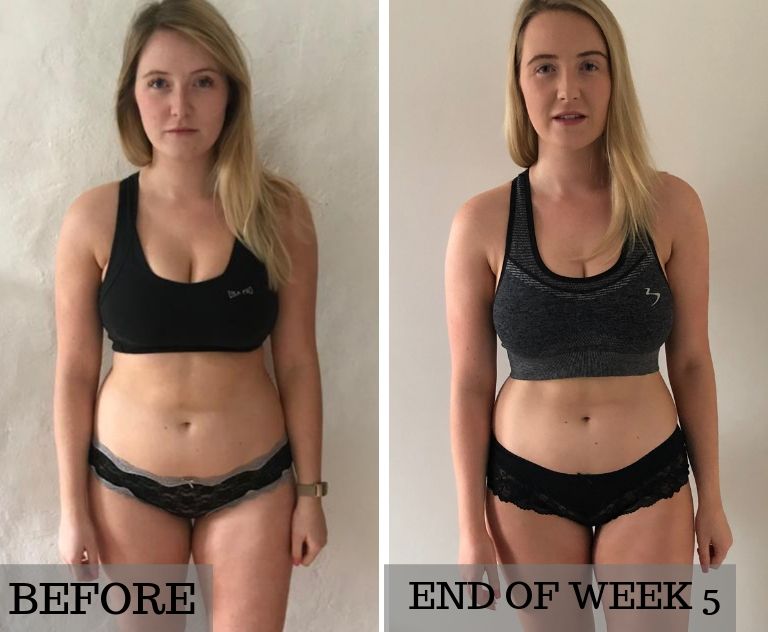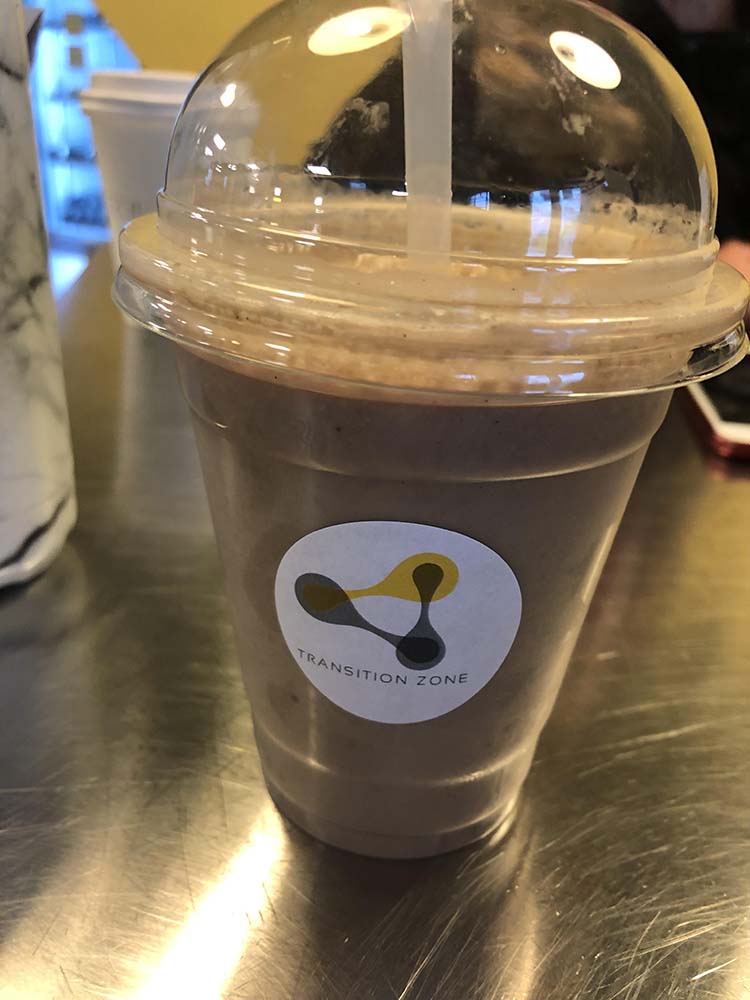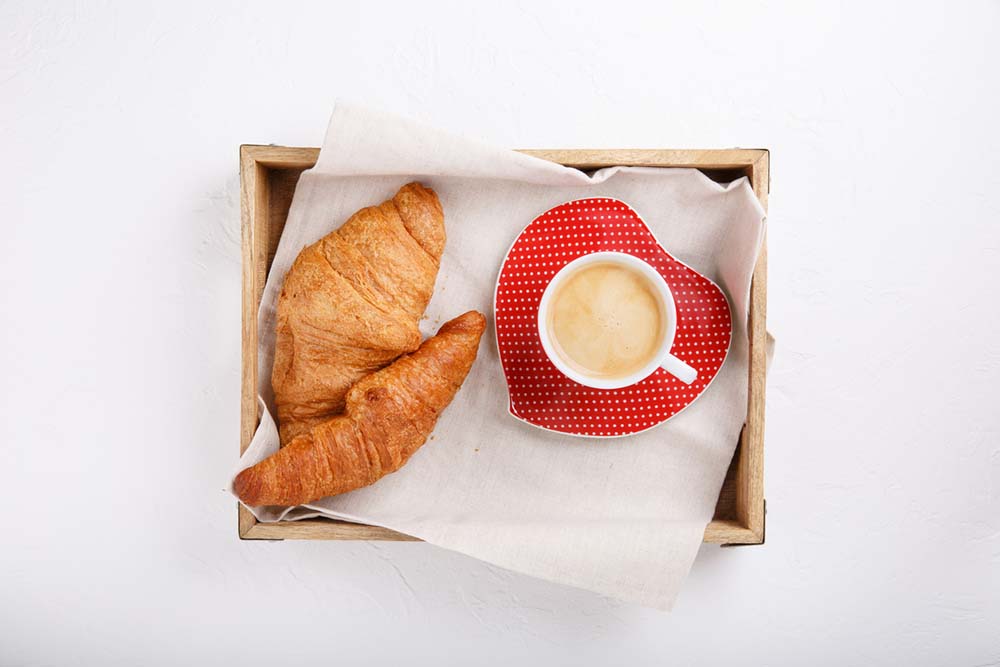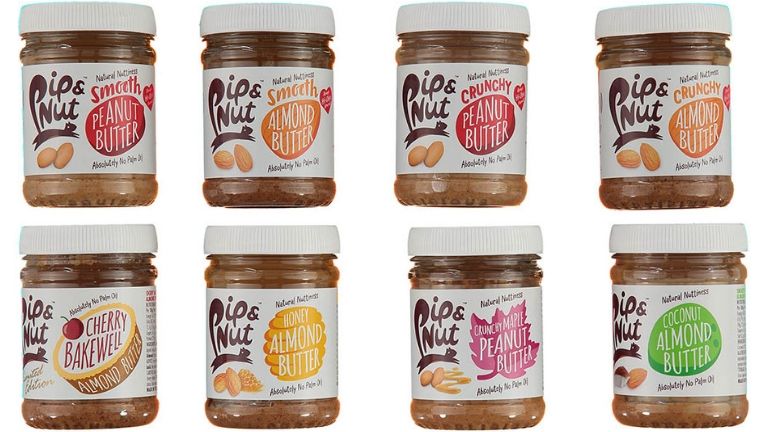Healthista’s Olivia Hartland-Robbins is on week five of her body transformation at Transition Zone gym and she has lost 5 per cent body fat and 4 kgs, without going hungry. Here’s how she did it
Wow week five already, time really does fly by when you’re having fun…. and losing loads of weight! Last week, it was all about upping the cardio.
This week it’s time to up the weights, which means it’s all the more important to meet my protein targets and eat the right foods.
| Before | Week 1 | Week 2 | Week 3 | Week 4 | Week 5 | |
| Weight kg | 68.9 | 67.4 | 66.3 | 65.5 | 64.8 | 64.8 |
| Body fat % | 27.0 | 25.8 | 24.2 | 24.6 | 23.2 | 22.8 |
| Hips cm | 107 | 107 | 104 | 105 | 104 | 104 |
| Waist cm | 77 | 75 | 74 | 73 | 71.5 | 71 |
| Stomach cm | 90 | 88 | 86 | 86 | 84 | 83 |
| Thighs cm | 56 | 55 | 54 | 55 | 54 | 54 |
| Overall weight loss kg | N/A | 1.5 | 2.6 | 3.4 | 4.1 | 4.1 |
7 rules for eating for weight loss when you’re training
At the beginning of my transformation I had a consultation with nutritionist Emma Bardwell, who asked me to fill out a questionnaire about my eating habits and overall health. After making a record of everything I ate and hearing what Emma had to say about it, I realised I had some big changes to make when it came to my diet.
I’d explained to my personal trainer Mark Stanton, as well as Emma, that my main goal was to lose body-fat. I didn’t want to get to the end of the transformation and find that my body-fat percentage had barely changed.
After the nutrition consultation, Emma (Instagram: @emma.bardwell) sent me a detailed nutrition plan of dos and don’ts to stick to over the next 12 weeks of the transformation. Emma also explained the importance of making long lasting, sustainable changes that get results but don’t feel restrictive.
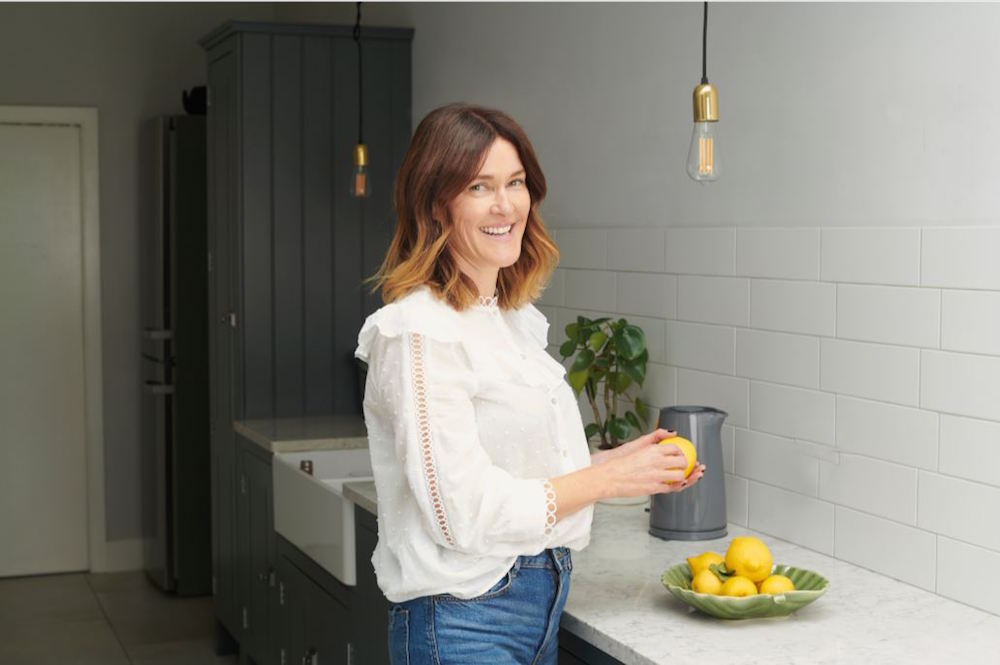
One thing both Emma and Mark both made clear was that body fat loss can’t be achieved with weight training alone, diet plays a key role.
So many people have been asking me, ‘Olivia what EXACTLY are you eating during this transformation?’ I generally tell them to read my week two article on eight diet rules to live by, but this week I have had to revisit those rules.
They might be good diet rules to live by as they are easy to maintain, but this week I am lifting heavier and feeling hungrier than ever, so here’s a revised version of those rules, explaining exactly what to eat when you are training hard, but still want to lose weight.
So here’s what I eat in a nutshell:
Training day:
Breakfast – Transition Zone protein smoothie, FAGE yoghurt, blueberries, almond butter, pumpkin seeds.
Lunch – chicken or turkey steak with roasted vegetables, boiled broccoli, chickpeas or lentils.
Dinner – Salmon or cod loin with boiled vegetables or salad.
Snacks – almonds, apple, almond butter, protein powder with water.
Non-training day:
Breakfast – FAGE yoghurt, raspberries, peanutbutter, pumpkin seeds.
Lunch – chicken or turkey steak with roasted vegetables and boiled broccoli.
Dinner – Salmon or cod with boiled asparagus and roasted butternut squash. Or shakshuka.
Snacks – almonds, clementine, one square dark chocolate.
Rule #1 Hit your protein target
I may have mentioned this in every one of my pieces, so get ready for yet another reminder because I am going to bang on about protein once again.
Protein is absolutely essential to us humans, it contains amino acids that are the building blocks of all our cells, our bodies can’t make these on their own.
Emma stressed this at the beginning of the transformation and that I’d need to focus on eating protein, protein and umm…more protein.
She suggested that I aim to eat 90 grams of protein (380 calories) on the days that I am working out and 80 grams (330 calories) on the days I am not. (These food targets were based on my body measurements and Base Metabolic Rate, and so may not be suitable for others to follow, plus that may change later on in the programme as my body mass changes). Read on to see exactly what I eat to get my 80 grams of protein in a day.
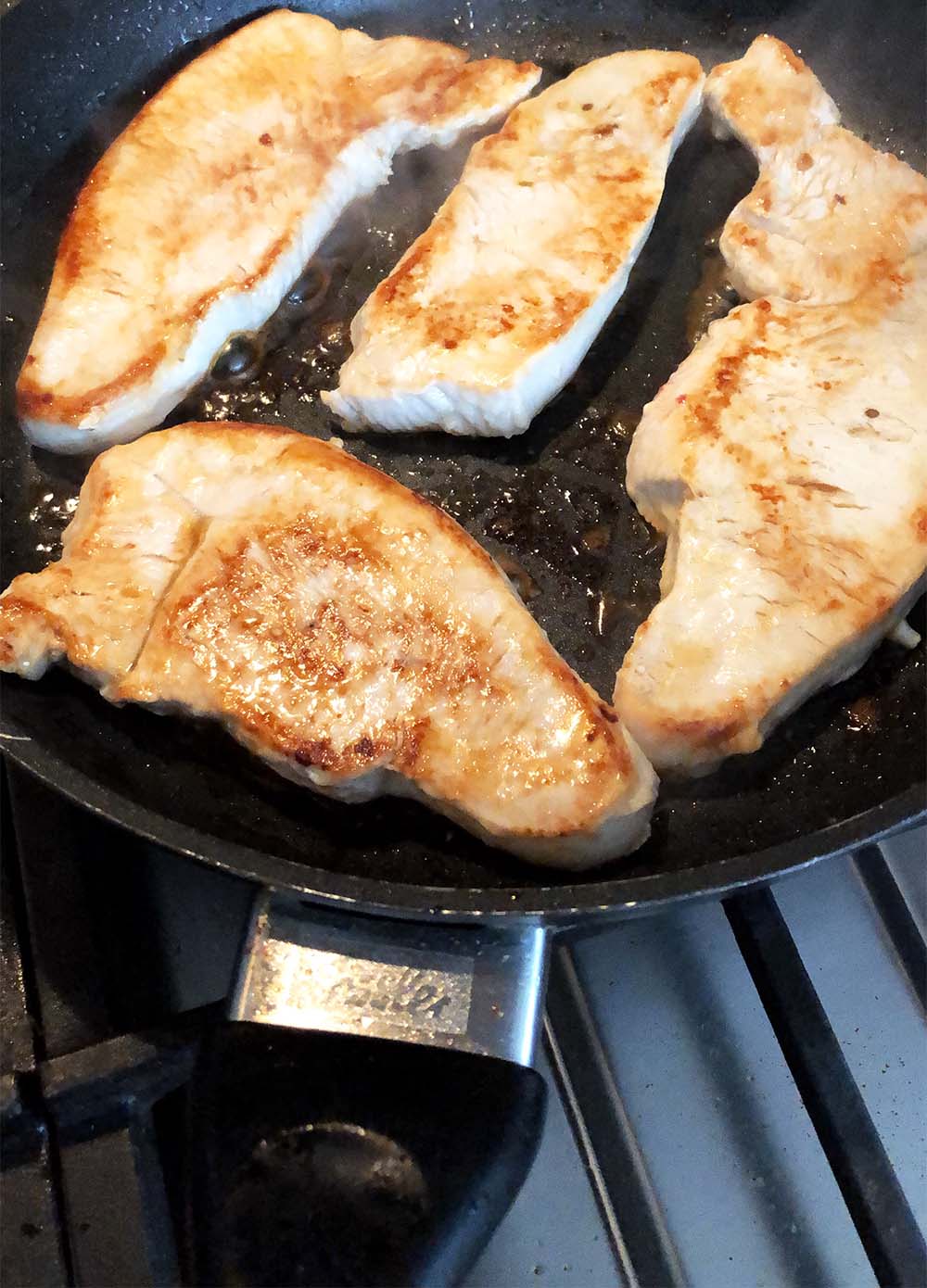
One of the key reasons Emma stressed the importance of hitting my protein target is because protein helps the body build lean muscle tissue, which is what helps your body to change shape when you are doing a transformation or any resistance training.
When you’re training hard, protein is essential because it means you won’t get any muscle wasting, but instead are constantly fuelling your muscles to grow and improve shape.
Research has shown that eating your protein spread out throughout the day is more effective, for building muscle, than eating the majority in the evening meal.
‘Protein is the most satiating macronutrient and during a transformation you want a diet high in protein, that will keep you feeling fuller for longer,’ explains Emma. ‘Protein will also slow the release of energy to help curb energy slumps throughout the day’.
So that’s an excellent reason to add protein to every snack and meal.
How much protein do you need?
According to government guidelines, your protein consumption should be 0.8 grams per kilogram of body weight. For an average sedentary woman, this is around 46 grams of protein per day and 56 grams for men.
However, this is the minimum daily average; your protein requirement will be based on your personal health goals and lifestyle as well as factors such as activity levels, age, muscle mass and your current health status.
We are all unique and have very individual requirements but take a look at these examples:
- If you’re an average healthy woman with a sedentary lifestyle aim to consume 1.0g/kg of body weight per day.
- If you exercise regularly aim to eat 1-1.6g/kg of body weight per day.
- If you’re very active and focusing on resistance training, consume around 1.2-2.0g/kg of body weight a day.
- If you want to lose weight and are training around three times per week, eat 1.2-1.5g/kg of body weight per day.
- If you’re a super fit endurance athlete aim to consume, 1.3-1.6g/kg of body weight.
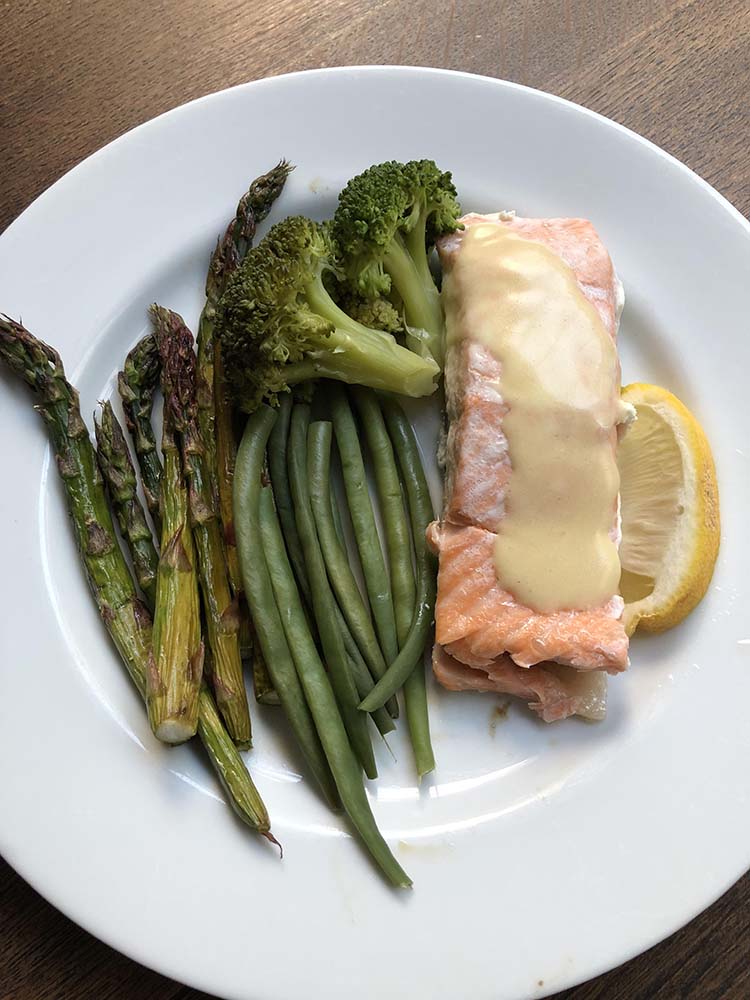
Sources of protein
Protein foods, as you’re probably aware, include all types of meat, poultry, eggs and fish, but also vegetarian sources such as tofu and tempeh, lentils and pulses, beans and nuts.
MORE: 22 vegan protein sources and exactly how to eat them
Protein dense foods include white meat (chicken or turkey), red meat (lamb, beef and pork), fish (which I’ve been advised to have at least twice a week, one of which should be oily fish) and some dairy like milk, yoghurt and cottage cheese.
‘Other options include pumpkin seeds, peanut butter, kidney beans, baked beans, lentils, quinoa, soy milk, green beans and oatmeal,’ says Emma.
Protein I’ve had this week:
Well for starters, I eat a lot of chicken, turkey and salmon. For lunch I eat chicken breast or eggs with vegetables or salad. Then, usually I eat fish and vegetables for dinner. My snacks? Generally a small piece of fruit and eight almonds, or some yoghurt. Fage is my favourite because its high in protein and low in sugar.
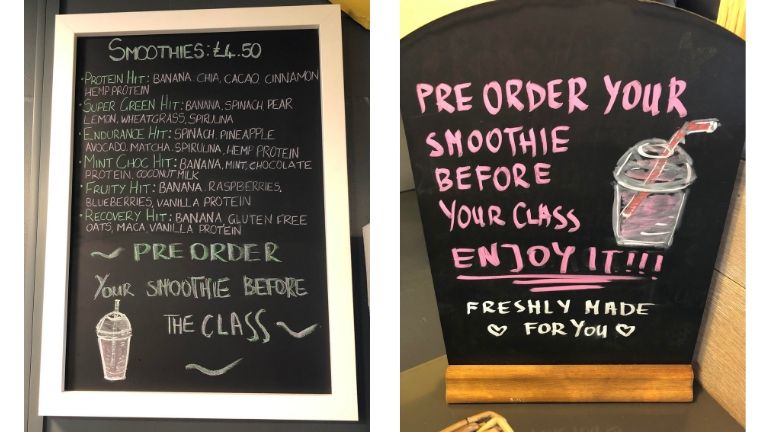
For breakfast, I also have yoghurt, and on training days I am treated to a delicious Transition Zone smoothie kick start my day on a protein high.
At Transition Zone, you can pre-order your smoothie before your class or training session so that it is waiting for you to enjoy straight after your session. Mark often says, ‘one more set and you’ve earnt that protein smoothie’. They really are delicious.
This delicious Transition Zone smoothie contains:
- Vanilla Vegan protein powder (around 17 grams protein)
- Cashew butter
- Gluten free oats
- Maca powder
- Almond milk
And here’s what I’ve been eating to hit my protein target:
- One medium chicken breast (contains 35 grams of protein)
- 100g of FAGE yoghurt (contains 10 grams of protein)
- One medium salmon steak (contains 30 grams of protein)
- One boiled egg (contains 6 grams of protein )
- That’s a total of 81 grams of protein.
Adding extras such as pumpkin seeds, pulses like chick peas and lentils, and my protein smoothie, can increase my protein intake to around 100 grams.
In fact, this week – due to me being hungrier than ever – I have also been having Healthista protein powder mixed with just water at around 4pm, I find this not only gets rid of those niggling feelings of hunger but also stops any sweet cravings I seem to get after eating my lunch – plus it’s added protein.
Rule #2 Be clever with carbs and fats
I knew when I started this journey that it would be goodbye to pasta (cries), bread and pastries (I love you croissants) – at least for a little while. I really am one of those people that just has to look at pasta or smell some bread and I will put on five pounds. So where do I get my carbs now?
Instead, I’ve switched to more nutrient dense carbs such as, sweet potato, butternut squash, quinoa, brown rice, oats and cous-cous. These are all great carbs that provide me with energy I need to train hard and good fuel for the tank to get me through the day.
Before I started, I would probably have had both butternut squash and rice in one meal – double carb alert. Not that there’s a problem with that of course, carbohydrates are the body’s preferred energy source after all. But during a transformation I do need to tone the carbs down a tad.
Now though, I know that by substituting the rice for more butternut squash, which contains more nutrients and won’t spike my blood sugar. That way I will still feel full after a meal and won’t be battling cravings. I am so loving butternut squash right now.
When we eat carbs, they undergo a process of digestion, absorption, and conversion into glucose. All the carbs we eat are converted into glucose and are sent out into the blood or stored as glycogen – a bunch of glucose molecules linked together and stored for when they are needed for energy, in either the muscles or liver. Eaten in excess, carbs are converted into fat, but when training hard this is rare.
If you don’t eat enough carbs, you might be able to get through a couple of good workouts, but sooner or later your ability to recover will be impaired and so will your performance, plus your brain needs carbs too.
High glycogen and blood glucose levels though (from eating carbs), will allow you to recover between sets and they can allow you to shorten your rest periods without impacting on your performance.
How many carbs should you be consuming?
- 0-1g carbs per lb bodyweight per day: Sedentary work (office job)
- 1-2g carbs per lb bodyweight per day: Moderately active job (personal trainer, waitress, walking or cycling to work)
- 2-3g carbs per lb bodyweight per day: High activity job (fitness instructor, construction worker)
- 3g plus carbs per lb bodyweight per day: High level endurance or fitness sport training (athlete)
As for fats, there are good fats and then there are bad fats, like the saturated fats found in junk and fast food. Good fats include, avocados, nuts, cheese, butter, coconut oil, olives and oils. ‘Fats are also essential for hormone synthesis,’ adds Emma.
Carbohydrates and protein contain four calories per gram, but fats contain nine calories per gram, meaning it’s easy to rack up the calories quicker. So the moral here is be careful. Sure, cold pressed olive oil is good for you (and tastes delicious) but if slosh all over every salad, you’ll soon be racking up the calories.
Aim to fill half your plate with vegetables, quarter of protein and a quarter of carbs.
Carbs and fats I’ve had this week:
I have been making an effort to stick to nutrient-dense carbs this week to help fuel my muscles as much as possible. Which means I have been roasting lots of butternut squash, sweet potato and chick peas, rather than relying on bread, pasta or rice.
As a treat for the weekend, I ordered a breakfast that came with rye bread – it was so delicious. I was also a bit naughty and bought some spicy cous-cous but I only had a very small amount.
In terms of fats, I have been eating loads of healthy good fats, all these are my faves: salmon, smoked salmon, avocado, nut butter, almonds, olive oil and some feta cheese.
https://www.instagram.com/p/BxKQdRHBuGf/?utm_source=ig_embed
Rule #3 Make vegetables your new fave thing
New recommendations now suggest that your daily fruit and veg intake should be ten portions and not five. Emma suggested that I should aim to ‘eat the rainbow’ and look to eat a variety of fruit and veg wherever possible.
By doing this your gut will love the fibre and thrive off the diversity of plant based foods, plus studies have shown that fibre helps reduce the risk of heart disease, type 2 diabetes, high cholesterol and balance blood sugar levels as well as maintain a healthy weight and promoting good digestion.
Fibre is lacking in the average UK diet, with most of us only achieving 50% of the recommended intake.
Fruits and vegetables also contain phytonutrients, which are not essential to life but have added health benefits. These plant compounds act as antioxidants in the body that help to reduce inflammation and the damage caused by excess free radicals that can build up because of a poor diet, environmental factors and stress, leaving us vulnerable to illness.
Such compounds give plants their bright colours such as beta carotene (found in orange and green varieties), anthocyanins (found in blue and purple varieties) and lycopene (found in red varieties).
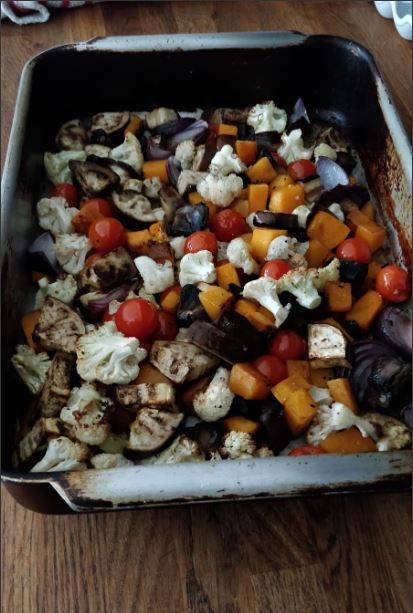
If you’re eating 10-a-day then the chances are you have a very healthy diet , which will increase your protection against diseases as well as help you maintain a healthy weight.
Some people may feel that cost is an issue when it comes to buying loads of veg, but frozen vegetables can provide a cheaper way to add these foods to your diet, without losing out on nutrients.
‘Canned pulses are a cheap way to add a serving of carbs as well as bulking out meals and adding protein and key minerals such as iron, calcium and zinc to your diet,’ suggests Emma. ‘You can also source cheaper vegetables from local markets and buying in season helps as well’.
Veg is also super low in calories, meaning you can eat way more vegetables than you can carbs and fat, so fill your plate full of them, literally your whole body will thank you.
Plus veg is so easy to prepare, boil it, steam it or roast it in bulk. Keep it cooked in the fridge so there is always a healthy option for you to reach for when you are feeling particularly hungry after a hard training session.
Rule #4 Buy some sauerkraut
Emma suggested that I try to include one portion of fermented food a day. The process of fermenting foods is the bacterial conversion of sugars and starches to acids, usually using a salt solution. This process encourages the good bacteria such as Lactobacilli and Bifidobacteria to flourish, making fermented food a good source of good bacteria or probiotics.
‘Fermented foods such as sauerkraut, kimchi and kefir are some of the more known foods that have become increasingly popular in recent years,’ explains Emma.
Essentially, good gut health is fundamental to our overall health and better gut health makes it easier to lose body fat and build muscle – excellent news if building muscle and losing body fat are your main goals eh?
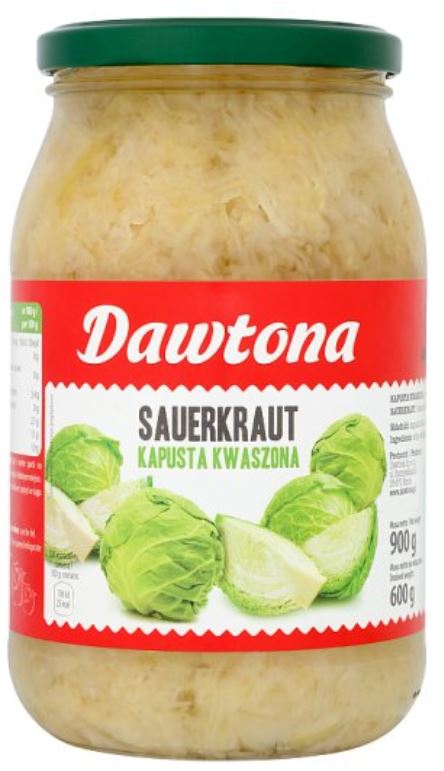
One fermented ingredient I have been adding to many of my meals is sauerkraut. Apparently, regularly consuming sauerkraut may help you lose weight and keep it off – bonus.
Sauerkraut, like most other vegetables, is low in calories and high in fibre. High-fibre diets keep you feeling full, which will naturally help reduce the amount of food you eat per day.
Sauerkraut’s high probiotic content may also contribute to a trimmer waistline. The exact reasons aren’t yet fully known, but scientists now believe that probiotics may have the ability to reduce the amount of fat your body absorbs from your diet.
Other studies found that participants given probiotic-rich foods or supplements, like Higher Nature’s Pro-Easy, lost more weight than those given a placebo.
A 2015 study in particular, found that purposely overfed participants given probiotics gained about 50 per cent less body fat than overfed participants who were given a placebo. This suggests that a probiotic-rich diet may even help in preventing weight gain.
Types of fermented food include:
- Live yoghurt (natural, greek high protein. eg: FAGE)
- Sauerkraut
- Kefir
- Kombucha
- Kimchi
- Miso
- Tempeh
- Natto
- Pickles
- Lassi
Rule #5 Don’t let yourself get too hungry
Training hard makes you more hungry – fact.
I’m normally one of those people who can get to midday without eating a thing and finds intermittent fasting a breeze, but there has been no chance of that happening this week – honestly thank God for those early morning Transition Zone smoothies.
I’m probably not alone in saying that when I get really hungry, that is the time I start to crave the simple carbs and refined sugars.
Sometimes I am so busy, I leave eating my lunch until I am starving, which isn’t ideal. Waiting too long between meals often means you end up eating more than you would usually. Plus, you end up eating so quickly that your brain doesn’t have time to register what you have even eaten and so you are still feel hungry after your meal.
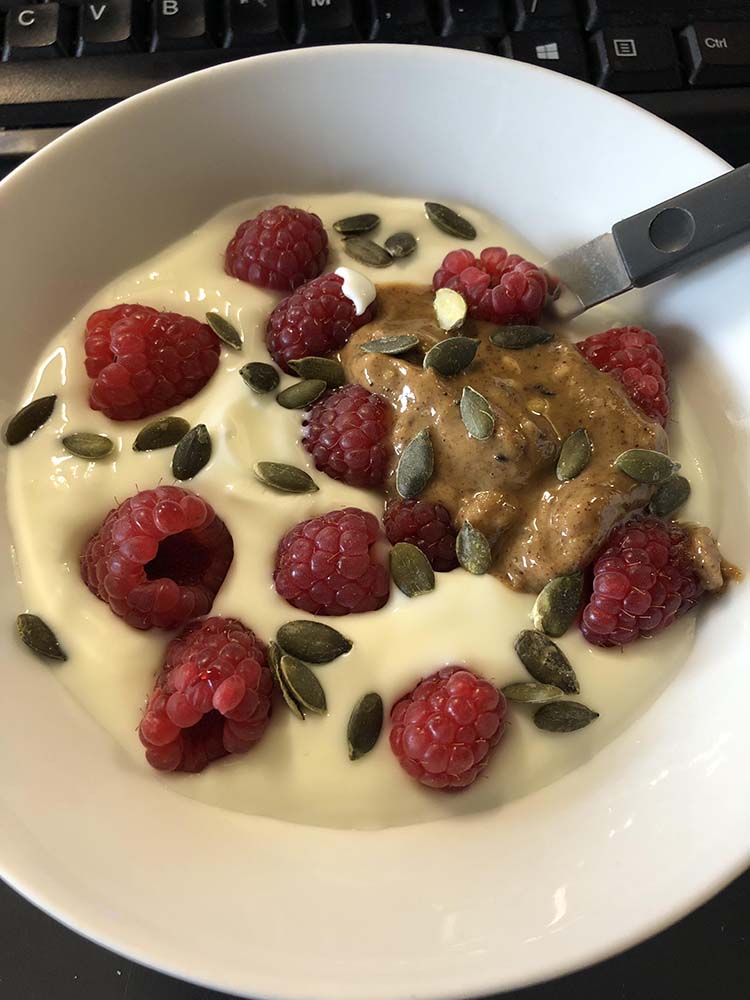
Even as those deadlines loom or your diary is full of meetings, try to avoid skipping meals so that you don’t get too hungry. Even a quick yoghurt and berry combo will help fill the hungry gap.
Ideally, if you plan your meals to combine slow release carbohydrates with good quality protein and plenty of fibre, you will stay full and have enough energy until your next meal.
Good food options to stop the hunger:
- Yoghurt with fruits, nuts and seeds
- Eggs with smoked salmon
- Overnight oats with chia seeds and fruit
- Avocado on sourdough/rye toast with boiled eggs
Rule #6 Plan your meals
If there is one piece of advice I can offer (other than eating enough protein of course) it would be to PLAN PLAN PLAN your meals (and lay out your gym gear next to your bed the night before obvs). And that doesn’t just mean writing down what you plan to have for the week, that means making your breakfast or lunch and even dinner the day before.
There have been some days, of course, when I haven’t been organised and have come home and literally just whisked up some scrambled eggs and eaten them.
But I have become pro at is making sure I make my lunch the night before, because I can guarantee, you will not wake up early to make your lunch, no matter what you tell yourself the night before. This will mean you end up buying a sandwich or snacking on things people bring into work, which is a big no no when trying to lose weight and eat the right foods to fuel your body.
Plus, if you plan your meals you are able to control how much protein you will be consuming that day. A sandwich is not going to help you get your protein needs.
Another top tip is to roast a whole load of vegetables every two to three days and keep them in the fridge. That way if you come home starving hungry you won’t have to wait 40 minutes for your veg to cook – why does roasted veg take so long?
Rule #7 Plan your snacks too
As well as planning meals, be sure to plan your snacks too. We all get peckish and bored and want a little snack here and there. But when those snacks are biscuits that a colleague has brought in, or a packet of crisps you found in the cupboard, you will not get any nutritional benefit from them, and they won’t fill you up at all.
Keep yoghurt in the fridge, boil some eggs, keep fruit nearby and buy some almonds that you can keep on your desk. Even eating just four almonds with a cup of tea can suffice as a snack – and guess what? It’s healthier than biscuits.
Workout of the week:
https://www.instagram.com/p/ByGctGgnqLc/?utm_source=ig_embed
Upper body/ lower body super-set: 3 sets each exercise
Single arm kneeling landmine press – 8 reps, assisted 20kg bar
Goblet squat – 10-12 reps, 20kg
Upper body/ lower body super-set: 3 sets each exercise
Romanian deadlift – 10 reps, 30kg
Single arm row – 10 reps, 12kg
Cardio/ core super-set: 3 sets each exercise
Sled push – x2 lengths, 125kg
Swiss ball plank variations – 10/12 reps
Make sure to stretch properly after your workout. Hold your stretches for 15 seconds
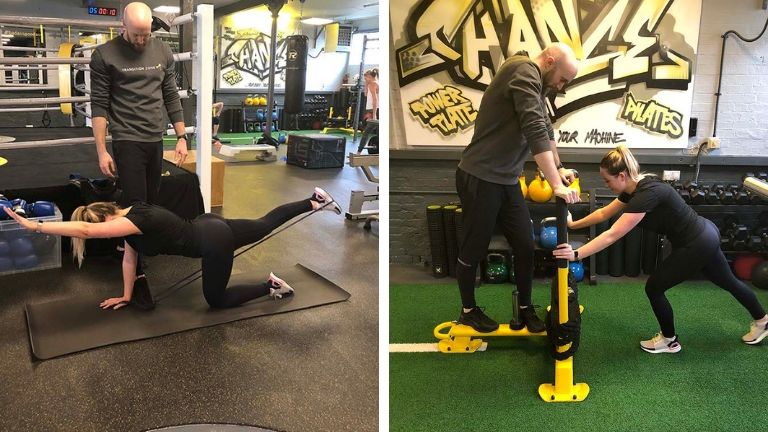
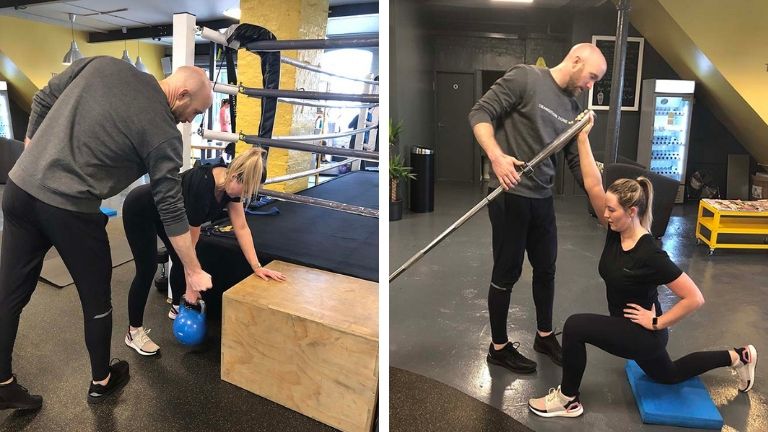
Things I learnt this week:
1. You don’t need alcohol to have fun: So this week my friend came to visit me. Now normally this involves a lot of alcohol and naughty foods (chocolate, cookies, garlic bread, crisps, curry, pasta, cheese – you name it we eat it – we are terrible influences on each other).
So because we couldn’t drink we decided not to go ‘out out’, as that would be far too tempting for me. Instead we went …. pottery painting. Now before you laugh we had a great time, who needs alcohol and food to have fun?
2. I’m obsessed with almond butter: Pip and Nut sent their entire range to Healthista HQ, I literally can’t stop spooning it out of the jar – someone pls send help or come and eat it all before I do.
Although nut butter is high in protein, it is also high in fat. In fact, Emma told me that one tablespoon of nut butter is equivalent to a Cadbury Flake in calories – so I could be suffering the consequences next time I get on the scales, check back in next week to see…
Come back every week to read Olivia’s week by week diary of her weight loss transformation with Mark Stanton and Emma Bardwell at Transition Zone.
Consultations and follow up appointments (including full dietary plan) £175
Get 20% off £140 for both – email welcome@transitionzone.co.uk mention HEALTHISTA.
For a free 15 minute introductory call to talk about goals, symptoms and expectations click here. And for new client offers click here. Follow Transition Zone on Instagram or see their website and latest newsletter for more information.
Win the ENTIRE range of Pip & Nut
Love nut butter? Take our quick survey for a chance to win a month’s supply (12 jars) of our current favourite, Pip & Nut, plus a luscious nut butter cookbook from founder Pippa Murray
More Healthista Content:
This 10-minute meditation boost your energy fast
How this gorgeous opera singer stays fit for stage
Do you have PCOS? This gynaecologist has help
8 best foods for glowing skin proven by science
The neuroscientist’s rule book for preventing dementia
Like this article? Sign up to our newsletter to get more articles like this delivered straight to your inbox.



